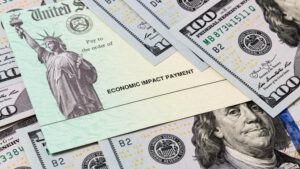AUGUST 22, 2022

In light of elevated inflation and a summer travel season defined by record-high gas prices, some states are using budget surpluses or other means to lend a hand to struggling residents.
More than a dozen states are currently distributing payments or will start issuing rebates soon.
In most cases, payments are contingent upon taxpayers having filed state returns. Those who requested filing extensions are typically still eligible but will receive payments later than those who paid their taxes on time.
California
California Gov. Gavin Newsom announced that millions of households will receive checks up to $1,050, with stimulus amounts varying by income and filing status.
Single filers will receive between $200 — plus $200 for at least one dependent — and $350 plus $350 for at least one dependent. Additional dependents don’t qualify for more stimulus.
Joint filers will receive between $400 plus $200 for dependents and $700 plus $350.
Qualifying Californians can expect to receive their payments between October 2022 and January 2023.
Colorado
Qualifying individual filers in Colorado will receive $750, and joint filers are eligible for $1,500 as part of the Colorado Cash Back tax rebate. Those who filed their taxes by June 30 will receive their payments by the end of September. Those who meet the Oct. 17 extension deadline will get their checks by the end of January 2023.
Delaware
Delaware House Bill 360 authorized $300 payments to every adult resident of the state, including some who didn’t file tax returns. Those who filed 2020 tax returns received their payments in May. Those who filed 2021 returns will receive payments throughout the summer.
Florida
Roughly 59,000 low-income Florida families with children will receive one-time payments of $450 per qualifying child, provided they are a foster parent, a relative or non-relative caregiver, TANF recipients or members of the Guardianship Assistance Program. According to CBS News, checks were set to arrive before the state’s back-to-school sales-tax holiday between July 25 and Aug. 7.
Georgia
Georgia began issuing payments up to $250 for single filers, $375 for head-of-household filers and $500 for joint filers in May. But according to the Office of the Governor, “It may take some time for all refunds to be processed” due to high volume. The amount received is based on the individual’s tax liability.
Hawaii
Hawaiians with incomes up to $100,000 — $200,000 for couples filing jointly — will receive $300. Anyone earning more will get $100. The government will start issuing rebates in the last week of August.
Idaho
Idahoans and each of their dependents will receive the greater amount of $75 or 12% of their 2020 income. The state started making 25,000 payments per week in the last week of March. Direct deposit payments go first, with those receiving checks getting their payments later.
Illinois
The Illinois Family Relief Program, which began on July 1, includes a variety of measures, including $50 tax rebates for those earning less than $200,000, or $400,000 for joint filers, plus $100 per dependent. Those checks are expected to roll out around Sept. 12. The program also includes a 10-day back-to-school sales tax reduction, a pause on a planned fuel tax increase and a freeze on the state sales tax for grocery store purchases.
Indiana
Indiana had already approved a $125 rebate for qualifying taxpayers who filed 2021 returns. On Aug. 5, Gov. Eric Holcomb approved an additional rebate of $200 for individual filers or $400 for joint filers. Anyone who qualified for the first rebate automatically qualifies for the second. Direct deposits were expected as early as Aug. 19.
Maine
Maine began issuing $850 rebates to qualifying residents in the first week of June, with eligible joint filers receiving $1,700. Most Mainers received their payments by mid-July, but residents have until Oct. 31 to file their tax returns to qualify for the rebate.
New Jersey
New Jersey’s Middle Class Tax Rebate program has ended, but the Affordable New Jersey Communities for Homeowners and Renters (ANCHOR) program will replace and expand the Homestead Rebate Program. Homeowners can receive up to $1,500, and renters can qualify for $450. The program begins in fiscal year 2023.
New Mexico
New Mexico approved payments up to $1,500 for families in the state, with payment amounts varying by filing status and income. The state issued over 2.4 million payments as of Aug. 15, but some are still trickling in.
South Carolina
South Carolina approved payments of up to $800 for taxpayers who file their returns by Oct. 17. All payments will be made by the end of the year.
Virginia
Qualifying Virginians will receive a one-time payment of $250 for individuals and $500 for couples filing jointly. Those who filed by July 1 will receive their payments by the end of October. All residents must file by Nov. 1 to receive the rebate.










































































































